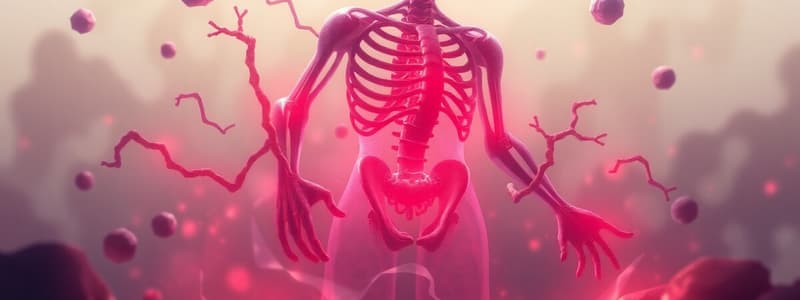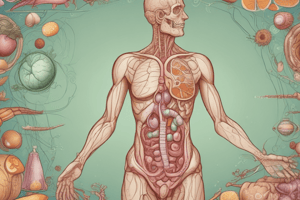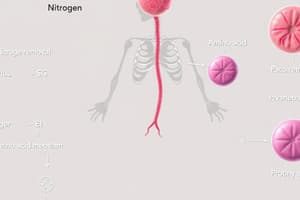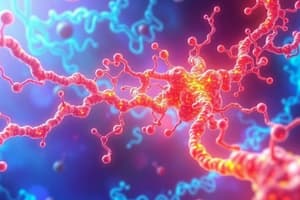Podcast
Questions and Answers
What is the primary role of carbamoyl phosphate in the urea cycle?
What is the primary role of carbamoyl phosphate in the urea cycle?
- It plays a role only in the energy generation processes.
- It functions primarily in the synthesis of herbal compounds.
- It serves as a precursor for urea synthesis. (correct)
- It acts solely as a source of nitrogen for amino acids.
Which factor is essential for the activation of carbamoyl phosphate synthetase I?
Which factor is essential for the activation of carbamoyl phosphate synthetase I?
- Bicarbonate
- Ornithine
- ADP
- N-acetylglutamate (correct)
How many moles of ATP are required for the synthesis of one mole of carbamoyl phosphate?
How many moles of ATP are required for the synthesis of one mole of carbamoyl phosphate?
- 1 mole
- 3 moles
- 4 moles
- 2 moles (correct)
What role do ornithine and lysine play in the urea cycle?
What role do ornithine and lysine play in the urea cycle?
What is one function of the mitochondria in the context of the urea cycle?
What is one function of the mitochondria in the context of the urea cycle?
What is the primary substrate for the synthesis of N-acetylglutamate in the urea cycle?
What is the primary substrate for the synthesis of N-acetylglutamate in the urea cycle?
Which enzyme catalyzes the conversion of citrulline and aspartate to argininosuccinate?
Which enzyme catalyzes the conversion of citrulline and aspartate to argininosuccinate?
How does starvation affect the levels of urea cycle enzymes?
How does starvation affect the levels of urea cycle enzymes?
What role does N-acetylglutamate play in the urea cycle?
What role does N-acetylglutamate play in the urea cycle?
Which of the following describes the entry and exit of intermediates in the urea cycle?
Which of the following describes the entry and exit of intermediates in the urea cycle?
What is required for the formation of argininosuccinate from citrulline and aspartate?
What is required for the formation of argininosuccinate from citrulline and aspartate?
In the context of the urea cycle, what is the significance of mitochondrial inner membrane carriers like ORC1 and ORC2?
In the context of the urea cycle, what is the significance of mitochondrial inner membrane carriers like ORC1 and ORC2?
Which of the following is a product of the hydrolysis reaction involving N-acetyl-L-glutamate?
Which of the following is a product of the hydrolysis reaction involving N-acetyl-L-glutamate?
What are the stages of urea biosynthesis?
What are the stages of urea biosynthesis?
Which amino acid is primarily released by muscles during protein metabolism?
Which amino acid is primarily released by muscles during protein metabolism?
How does the liver's capacity for gluconeogenesis from alanine change in starvation?
How does the liver's capacity for gluconeogenesis from alanine change in starvation?
What is the role of transamination in amino acid metabolism?
What is the role of transamination in amino acid metabolism?
Why is alanine a key gluconeogenic amino acid?
Why is alanine a key gluconeogenic amino acid?
What is the primary metabolic role of ornithine in mammals?
What is the primary metabolic role of ornithine in mammals?
What enhances the expression of urea cycle enzymes in the liver during starvation?
What enhances the expression of urea cycle enzymes in the liver during starvation?
What is primarily transported by mitochondria in the urea cycle?
What is primarily transported by mitochondria in the urea cycle?
Which of the following substrates is required for the synthesis of one mole of urea?
Which of the following substrates is required for the synthesis of one mole of urea?
What role does N-acetylglutamate play in the urea cycle?
What role does N-acetylglutamate play in the urea cycle?
Which enzyme is NOT typically active in the urea cycle?
Which enzyme is NOT typically active in the urea cycle?
Where does the majority of the urea synthesis cycle occur within the cell?
Where does the majority of the urea synthesis cycle occur within the cell?
What role do branched-chain amino acids play in nitrogen metabolism?
What role do branched-chain amino acids play in nitrogen metabolism?
Which enzyme initiates the biosynthesis of urea?
Which enzyme initiates the biosynthesis of urea?
What concentration level of alanine indicates saturation for gluconeogenesis in the liver?
What concentration level of alanine indicates saturation for gluconeogenesis in the liver?
What adaptation does the body use to maintain acid-base balance relating to ammonia production?
What adaptation does the body use to maintain acid-base balance relating to ammonia production?
Which of the following is NOT involved in urea synthesis?
Which of the following is NOT involved in urea synthesis?
What contributes nitrogen to the formation of urea?
What contributes nitrogen to the formation of urea?
In which part of cellular metabolism do the reactions of the urea cycle primarily occur?
In which part of cellular metabolism do the reactions of the urea cycle primarily occur?
Which substance is consumed in the urea cycle but is ultimately regenerated by the end of the cycle?
Which substance is consumed in the urea cycle but is ultimately regenerated by the end of the cycle?
Which compound is a precursor in the biosynthesis of urea that contributes nitrogen atoms?
Which compound is a precursor in the biosynthesis of urea that contributes nitrogen atoms?
What role does N-acetylglutamate play in the urea cycle?
What role does N-acetylglutamate play in the urea cycle?
Where in the cell is carbamoyl phosphate synthetase I primarily located?
Where in the cell is carbamoyl phosphate synthetase I primarily located?
Which enzyme defect would most likely impair the early steps of the urea cycle leading to hyperammonemia?
Which enzyme defect would most likely impair the early steps of the urea cycle leading to hyperammonemia?
What is the primary analytical method employed for newborn screening of metabolic disorders in the United States?
What is the primary analytical method employed for newborn screening of metabolic disorders in the United States?
Which of the following disorders would NOT typically be detected by newborn metabolic screening?
Which of the following disorders would NOT typically be detected by newborn metabolic screening?
Which of the following compounds is produced as a result of nitrogen metabolism in the context of the urea cycle?
Which of the following compounds is produced as a result of nitrogen metabolism in the context of the urea cycle?
What type of metabolic diseases are primarily associated with deficiencies in the urea cycle?
What type of metabolic diseases are primarily associated with deficiencies in the urea cycle?
Which amino acid is crucial for providing nitrogen in the synthesis of urea?
Which amino acid is crucial for providing nitrogen in the synthesis of urea?
Which organ is primarily responsible for the synthesis of urea in the urea cycle?
Which organ is primarily responsible for the synthesis of urea in the urea cycle?
Which amino acid is released by muscles and taken up predominantly by the brain during protein metabolism?
Which amino acid is released by muscles and taken up predominantly by the brain during protein metabolism?
What physiological condition significantly increases the expression of enzymes in the urea cycle?
What physiological condition significantly increases the expression of enzymes in the urea cycle?
Which of the following stages is NOT a part of urea biosynthesis?
Which of the following stages is NOT a part of urea biosynthesis?
What is the primary role of branched-chain amino acids in nitrogen metabolism?
What is the primary role of branched-chain amino acids in nitrogen metabolism?
What concentration level of alanine triggers the liver's capacity for gluconeogenesis to reach saturation?
What concentration level of alanine triggers the liver's capacity for gluconeogenesis to reach saturation?
Which enzyme is involved in the transamination process that interconverts pairs of α-amino acids and α-keto acids?
Which enzyme is involved in the transamination process that interconverts pairs of α-amino acids and α-keto acids?
What happens to the rate of gluconeogenesis from alanine as the alanine concentration increases?
What happens to the rate of gluconeogenesis from alanine as the alanine concentration increases?
What role does pyridoxal phosphate (PLP) play during transamination?
What role does pyridoxal phosphate (PLP) play during transamination?
What is a direct product of the enzyme-bound Schiff base rearrangement during transamination?
What is a direct product of the enzyme-bound Schiff base rearrangement during transamination?
Which metabolites are produced during the conversion of an amino acid via l-amino acid oxidase?
Which metabolites are produced during the conversion of an amino acid via l-amino acid oxidase?
How is ammonia typically removed from circulation?
How is ammonia typically removed from circulation?
What is the maximum concentration of ammonia normally present in peripheral blood?
What is the maximum concentration of ammonia normally present in peripheral blood?
Which enzyme is primarily associated with the transamination process involving the addition and release of substrates?
Which enzyme is primarily associated with the transamination process involving the addition and release of substrates?
What is formed after the removal of the α-amino nitrogen from an amino acid during transamination?
What is formed after the removal of the α-amino nitrogen from an amino acid during transamination?
What substance is produced when hydrogen peroxide is split by catalase?
What substance is produced when hydrogen peroxide is split by catalase?
Which of the following reflects the fate of reduced flavin in the process described?
Which of the following reflects the fate of reduced flavin in the process described?
Which enzyme deficiency is characterized by a phenotype indistinguishable from that caused by a defect in carbamoyl phosphate synthetase I?
Which enzyme deficiency is characterized by a phenotype indistinguishable from that caused by a defect in carbamoyl phosphate synthetase I?
What is the primary metabolic consequence of defects in the urea cycle enzymes characterized by the accumulation of ammonia?
What is the primary metabolic consequence of defects in the urea cycle enzymes characterized by the accumulation of ammonia?
What is a key characteristic of the syndrome resulting from mutations in the ORC1 gene?
What is a key characteristic of the syndrome resulting from mutations in the ORC1 gene?
Which of the following genetic diseases related to the urea cycle is the most rare, with an estimated frequency of 1:62,000?
Which of the following genetic diseases related to the urea cycle is the most rare, with an estimated frequency of 1:62,000?
Which compound is essential for the enzymatic activity of carbamoyl phosphate synthetase I and is also involved in its regulation?
Which compound is essential for the enzymatic activity of carbamoyl phosphate synthetase I and is also involved in its regulation?
What is the primary product formed when glutamate is synthesized through the action of glutamate dehydrogenase?
What is the primary product formed when glutamate is synthesized through the action of glutamate dehydrogenase?
In the 'ping-pong' mechanism for transamination, which compound serves as the amino group donor?
In the 'ping-pong' mechanism for transamination, which compound serves as the amino group donor?
Which oxido-reductant can be utilized in the reaction catalyzed by glutamate dehydrogenase?
Which oxido-reductant can be utilized in the reaction catalyzed by glutamate dehydrogenase?
What type of reaction is primarily associated with the enzyme pyridoxal phosphate?
What type of reaction is primarily associated with the enzyme pyridoxal phosphate?
Which of the following amino acids can be directly synthesized from pyruvate?
Which of the following amino acids can be directly synthesized from pyruvate?
What type of enzyme is glutamate synthase considered to be in amino acid metabolism?
What type of enzyme is glutamate synthase considered to be in amino acid metabolism?
Which key intermediate is involved in the formation of L-glutamate during the reaction catalyzed by glutamate dehydrogenase?
Which key intermediate is involved in the formation of L-glutamate during the reaction catalyzed by glutamate dehydrogenase?
What effect does the reaction catalyzed by glutamate dehydrogenase strongly favor?
What effect does the reaction catalyzed by glutamate dehydrogenase strongly favor?
Which biomolecule serves as a cofactor in the transamination reactions described in the ping-pong mechanism?
Which biomolecule serves as a cofactor in the transamination reactions described in the ping-pong mechanism?
How does glutamate contribute to the urea cycle?
How does glutamate contribute to the urea cycle?
What metabolic principle explains the fact that various mutations can lead to identical clinical symptoms in patients?
What metabolic principle explains the fact that various mutations can lead to identical clinical symptoms in patients?
Which of the following methods is used to identify intermediates in a metabolic pathway before a block occurs?
Which of the following methods is used to identify intermediates in a metabolic pathway before a block occurs?
Which deficiency is associated with impaired activity of carbamoyl phosphate synthetase I?
Which deficiency is associated with impaired activity of carbamoyl phosphate synthetase I?
Definitive diagnosis of a metabolic disorder often requires what specific step?
Definitive diagnosis of a metabolic disorder often requires what specific step?
How do metabolic perturbations need to be managed when administering therapies for inherited metabolic diseases?
How do metabolic perturbations need to be managed when administering therapies for inherited metabolic diseases?
What type of inheritance pattern is often evident in genetic mutations affecting enzyme-catalyzed reactions in metabolic pathways?
What type of inheritance pattern is often evident in genetic mutations affecting enzyme-catalyzed reactions in metabolic pathways?
Which reaction in the urea cycle is analogous to a reaction in the citric acid cycle?
Which reaction in the urea cycle is analogous to a reaction in the citric acid cycle?
An exponential increase in DNA sequencing has contributed to the identification of what in the context of inherited metabolic diseases?
An exponential increase in DNA sequencing has contributed to the identification of what in the context of inherited metabolic diseases?
What is the role of aspartate in the reaction catalyzed by argininosuccinate lyase?
What is the role of aspartate in the reaction catalyzed by argininosuccinate lyase?
In assessing a patient for a urea cycle disorder, which test is commonly prioritized first?
In assessing a patient for a urea cycle disorder, which test is commonly prioritized first?
Match the following enzymes with their corresponding substrates:
Match the following enzymes with their corresponding substrates:
Match the following amino acids with their transamination involvement:
Match the following amino acids with their transamination involvement:
Match the following nitrogen metabolism processes with their outcomes:
Match the following nitrogen metabolism processes with their outcomes:
Match the following coenzymes with their respective reactions:
Match the following coenzymes with their respective reactions:
Match the following metabolic terms with their definitions:
Match the following metabolic terms with their definitions:
Match the following terms related to nitrogen metabolism with their descriptions:
Match the following terms related to nitrogen metabolism with their descriptions:
Match the following pathways in protein turnover with their characteristics:
Match the following pathways in protein turnover with their characteristics:
Match the following amino acids with their roles in nitrogen metabolism:
Match the following amino acids with their roles in nitrogen metabolism:
Match the following enzymes with their functions in urea biosynthesis:
Match the following enzymes with their functions in urea biosynthesis:
Match the following metabolic products with their origins:
Match the following metabolic products with their origins:
Flashcards
Urea Cycle
Urea Cycle
A metabolic pathway that converts ammonia into urea, a less toxic form of nitrogenous waste, allowing for its excretion.
Carbamoyl Phosphate Synthetase I
Carbamoyl Phosphate Synthetase I
Enzyme that initiates the urea cycle by converting ammonia, bicarbonate, and ATP to carbamoyl phosphate, a key reactant.
N-acetylglutamate
N-acetylglutamate
An allosteric activator of Carbamoyl Phosphate Synthetase I, regulating the urea cycle's activity.
Ornithine
Ornithine
Signup and view all the flashcards
Citrulline
Citrulline
Signup and view all the flashcards
Argininosuccinate Synthetase
Argininosuccinate Synthetase
Signup and view all the flashcards
Argininosuccinate
Argininosuccinate
Signup and view all the flashcards
Energy Requirements (Urea Cycle)
Energy Requirements (Urea Cycle)
Signup and view all the flashcards
Starvation and Urea Cycle
Starvation and Urea Cycle
Signup and view all the flashcards
Metabolic Disorders
Metabolic Disorders
Signup and view all the flashcards
Urea Synthesis
Urea Synthesis
Signup and view all the flashcards
Ammonia
Ammonia
Signup and view all the flashcards
Carbamoyl Phosphate Synthetase I
Carbamoyl Phosphate Synthetase I
Signup and view all the flashcards
Urea
Urea
Signup and view all the flashcards
Acid-Base Balance
Acid-Base Balance
Signup and view all the flashcards
Ornithine
Ornithine
Signup and view all the flashcards
Aspartate
Aspartate
Signup and view all the flashcards
Muscle Alanine Release
Muscle Alanine Release
Signup and view all the flashcards
Alanine's Role in Gluconeogenesis
Alanine's Role in Gluconeogenesis
Signup and view all the flashcards
Hepatic Gluconeogenesis Capacity
Hepatic Gluconeogenesis Capacity
Signup and view all the flashcards
Branched-chain amino acids (BCAAs)
Branched-chain amino acids (BCAAs)
Signup and view all the flashcards
Urea Biosynthesis Stages
Urea Biosynthesis Stages
Signup and view all the flashcards
Transamination
Transamination
Signup and view all the flashcards
Urea Cycle
Urea Cycle
Signup and view all the flashcards
Metabolite Diseases
Metabolite Diseases
Signup and view all the flashcards
Tandem Mass Spectrometry
Tandem Mass Spectrometry
Signup and view all the flashcards
Newborn Screening
Newborn Screening
Signup and view all the flashcards
Organic acidemias
Organic acidemias
Signup and view all the flashcards
Aminoacidemias
Aminoacidemias
Signup and view all the flashcards
Fatty Acid Oxidation Defects
Fatty Acid Oxidation Defects
Signup and view all the flashcards
Urea Cycle Enzymes
Urea Cycle Enzymes
Signup and view all the flashcards
Dietary Intervention
Dietary Intervention
Signup and view all the flashcards
Urea Cycle
Urea Cycle
Signup and view all the flashcards
Carbamoyl Phosphate Synthetase I
Carbamoyl Phosphate Synthetase I
Signup and view all the flashcards
N-acetylglutamate
N-acetylglutamate
Signup and view all the flashcards
Arginine
Arginine
Signup and view all the flashcards
Ornithine
Ornithine
Signup and view all the flashcards
ATP use in Urea Cycle
ATP use in Urea Cycle
Signup and view all the flashcards
Arginase
Arginase
Signup and view all the flashcards
Muscle Alanine Release
Muscle Alanine Release
Signup and view all the flashcards
Alanine's Role in Gluconeogenesis
Alanine's Role in Gluconeogenesis
Signup and view all the flashcards
Hepatic Gluconeogenesis Capacity
Hepatic Gluconeogenesis Capacity
Signup and view all the flashcards
Branched-chain amino acids (BCAAs)
Branched-chain amino acids (BCAAs)
Signup and view all the flashcards
Urea Biosynthesis Stages
Urea Biosynthesis Stages
Signup and view all the flashcards
Transamination
Transamination
Signup and view all the flashcards
Transamination
Transamination
Signup and view all the flashcards
Ammonia Removal
Ammonia Removal
Signup and view all the flashcards
Urea Cycle
Urea Cycle
Signup and view all the flashcards
Pyridoxal Phosphate (PLP)
Pyridoxal Phosphate (PLP)
Signup and view all the flashcards
Ammonia Intoxication
Ammonia Intoxication
Signup and view all the flashcards
Carbamoyl Phosphate Synthetase I
Carbamoyl Phosphate Synthetase I
Signup and view all the flashcards
Urea
Urea
Signup and view all the flashcards
Argininosuccinate Cleavage
Argininosuccinate Cleavage
Signup and view all the flashcards
Inherited Metabolic Diseases
Inherited Metabolic Diseases
Signup and view all the flashcards
Rational Therapy
Rational Therapy
Signup and view all the flashcards
Metabolic Screening
Metabolic Screening
Signup and view all the flashcards
Enzyme Activity Assay
Enzyme Activity Assay
Signup and view all the flashcards
DNA Sequencing
DNA Sequencing
Signup and view all the flashcards
Carbamoyl Phosphate Synthetase I
Carbamoyl Phosphate Synthetase I
Signup and view all the flashcards
Transamination
Transamination
Signup and view all the flashcards
Ammonia Toxicity
Ammonia Toxicity
Signup and view all the flashcards
Urea Cycle
Urea Cycle
Signup and view all the flashcards
Carbamoyl Phosphate Synthetase I
Carbamoyl Phosphate Synthetase I
Signup and view all the flashcards
Urea
Urea
Signup and view all the flashcards
Glutamate Dehydrogenase
Glutamate Dehydrogenase
Signup and view all the flashcards
Alpha-ketoglutarate
Alpha-ketoglutarate
Signup and view all the flashcards
Pyridoxal Phosphate
Pyridoxal Phosphate
Signup and view all the flashcards
Hyperammonemia Type 1
Hyperammonemia Type 1
Signup and view all the flashcards
N-Acetylglutamate Synthetase (NAGS)
N-Acetylglutamate Synthetase (NAGS)
Signup and view all the flashcards
Urea Cycle Disorders
Urea Cycle Disorders
Signup and view all the flashcards
Hyperammonemia
Hyperammonemia
Signup and view all the flashcards
Carbamoyl Phosphate Synthetase I
Carbamoyl Phosphate Synthetase I
Signup and view all the flashcards
Metabolic enzyme disorders
Metabolic enzyme disorders
Signup and view all the flashcards
Ammonia Intoxication
Ammonia Intoxication
Signup and view all the flashcards
Interorgan Amino Acid Exchange
Interorgan Amino Acid Exchange
Signup and view all the flashcards
Alanine's Role
Alanine's Role
Signup and view all the flashcards
Amino Acid Levels
Amino Acid Levels
Signup and view all the flashcards
Muscle Release
Muscle Release
Signup and view all the flashcards
Liver Uptake
Liver Uptake
Signup and view all the flashcards
Gluconeogenesis
Gluconeogenesis
Signup and view all the flashcards
Post-absorptive state
Post-absorptive state
Signup and view all the flashcards
Animal Nitrogen Excretion
Animal Nitrogen Excretion
Signup and view all the flashcards
Ammonia Excretion (Fish)
Ammonia Excretion (Fish)
Signup and view all the flashcards
Uric Acid Excretion (Birds)
Uric Acid Excretion (Birds)
Signup and view all the flashcards
Urea Excretion (Humans)
Urea Excretion (Humans)
Signup and view all the flashcards
Glucose-Alanine Cycle
Glucose-Alanine Cycle
Signup and view all the flashcards
Alanine Synthesis
Alanine Synthesis
Signup and view all the flashcards
Alanine's Role
Alanine's Role
Signup and view all the flashcards
Transamination
Transamination
Signup and view all the flashcards
Oxidative Deamination
Oxidative Deamination
Signup and view all the flashcards
Glutamate
Glutamate
Signup and view all the flashcards
Ammonia
Ammonia
Signup and view all the flashcards
Urea Cycle
Urea Cycle
Signup and view all the flashcards
Urea
Urea
Signup and view all the flashcards
Aminotransferases
Aminotransferases
Signup and view all the flashcards
Alanine-pyruvate aminotransferase
Alanine-pyruvate aminotransferase
Signup and view all the flashcards
Liver Glutamate Dehydrogenase (GDH)
Liver Glutamate Dehydrogenase (GDH)
Signup and view all the flashcards
Protein Turnover
Protein Turnover
Signup and view all the flashcards
Protein Turnover Rate (Healthy)
Protein Turnover Rate (Healthy)
Signup and view all the flashcards
High Protein Degradation Rate
High Protein Degradation Rate
Signup and view all the flashcards
ATP-Dependent Protein Degradation
ATP-Dependent Protein Degradation
Signup and view all the flashcards
ATP-Independent Protein Degradation
ATP-Independent Protein Degradation
Signup and view all the flashcards
Proteasome
Proteasome
Signup and view all the flashcards
Ubiquitin
Ubiquitin
Signup and view all the flashcards
Cell Surface Receptors
Cell Surface Receptors
Signup and view all the flashcards
Lysosomes
Lysosomes
Signup and view all the flashcards
Nitrogen Catabolism (Mammals)
Nitrogen Catabolism (Mammals)
Signup and view all the flashcards
Nitrogen Catabolism (Birds & Fish)
Nitrogen Catabolism (Birds & Fish)
Signup and view all the flashcards
Transaminases
Transaminases
Signup and view all the flashcards
Glutamate Dehydrogenase
Glutamate Dehydrogenase
Signup and view all the flashcards
Glutaminase
Glutaminase
Signup and view all the flashcards
Urea
Urea
Signup and view all the flashcards
Urea Cycle
Urea Cycle
Signup and view all the flashcards
Metabolic Defects
Metabolic Defects
Signup and view all the flashcards
Newborn Screening
Newborn Screening
Signup and view all the flashcards
Tandem Mass Spectrometry
Tandem Mass Spectrometry
Signup and view all the flashcards
Study Notes
Protein Turnover
- Protein turnover is the mean rate of protein turnover in healthy individuals
- Some human proteins are degraded at rates higher than the average rate
- Protein turnover involves ATP-dependent and ATP-independent pathways
- Proteasomes, ubiquitin, cell surface receptors, circulating asialoglycoproteins, and lysosomes play roles in protein degradation
Nitrogen Catabolism
- The end products of nitrogen catabolism in mammals differ from those in birds and fish
- Transaminases (aminotransferases), glutamate dehydrogenase, and glutaminase are central to human nitrogen metabolism
- Reactions convert ammonia, carbon dioxide, and aspartate into urea
- Urea synthesis occurs in different cellular locations
- Allosteric regulation and acetylglutamate regulate early steps of urea synthesis
- Defects in urea cycle enzymes result in similar clinical signs and symptoms but distinct at a molecular level
Biomedical Importance
- Nitrogen intake equals nitrogen excretion in normal adults
- Positive nitrogen balance (ingested nitrogen > excreted nitrogen) occurs during growth and pregnancy
- Negative nitrogen balance (excreted nitrogen > ingested nitrogen) occurs in conditions such as surgery, advanced cancer, and certain nutritional disorders
- Genetic disorders affecting ubiquitin, ubiquitin ligases, or deubiquitinating enzymes lead to diseases like Angelman syndrome, juvenile Parkinson disease, von Hippel-Lindau syndrome, and congenital polycythemia
- Ammonia, highly toxic, arises primarily from amino acid a-amino nitrogen
- Tissues convert ammonia to glutamine, then to urea for excretion
- Liver dysfunction leads to elevated blood ammonia, causing clinical symptoms
- Urea cycle enzymes are examples of metabolic defects linked to various physiologic consequences
- Urea cycle provides a molecular model for studying other human metabolic defects
Protein Degradation
- Protein degradation occurs at different rates depending on tissue and protein type
- Proteins not immediately used for new protein synthesis are rapidly degraded
- Carbon skeletons of amino acids convert to intermediates for metabolic use, and nitrogen is converted to urea for excretion
- Proteases hydrolyze internal peptide bonds
- Peptides are further degraded to amino acids by endopeptidases, aminopeptidases, and carboxypeptidases
ATP-Independent Degradation
- Blood glycoproteins are degraded by losing sialic acid, followed by internalization and lysosomal breakdown by proteases
- Extracellular, membrane-associated, and long-lived intracellular proteins are also degraded in lysosomes
ATP & Ubiquitin-Dependent Degradation
- Abnormal or misfolded proteins are degraded
- Ubiquitin, a small polypeptide, targets intracellular proteins for degradation
- Ubiquitin is highly conserved in structure
- Ubiquitin molecules attach to target proteins via non-peptide bonds
- Proteins are marked for degradation in the cytosol
Proteasome
- Ubiquitin-tagged proteins are degraded in the proteasome, a macromolecule
- Proteasomes contain proteolytic enzymes
- Proteins tagged with multiple ubiquitin molecules enter the proteasome core
- Proteasomes help clear abnormal or misfolded proteins
Interorgan Exchange
- Muscle is a major source of amino acids for the body
- Liver plays a critical role in urea synthesis and gluconeogenesis from alanine
- Kidney removes waste nitrogen and glutamine
Urea synthesis
- Urea is the primary nitrogenous waste product in humans
- Urea synthesis occurs in the liver in four stages: transamination, oxidative deamination of glutamate, ammonia transport, and urea cycle reactions
- Synthesis of 1 mole of urea requires 3 moles of ATP and utilizes several enzymes
- Urea synthesis involves mitochondrial and cytosolic steps
Metabolic Disorders
- Defects in the urea cycle are characterized by hyperammonemia
- Clinical symptoms include various neurological problems and severe mental retardation
- Early detection and dietary intervention can improve the outcome for these disorders
- Tandem mass spectrometry is a powerful technique used in newborn screening for metabolic disorders
Studying That Suits You
Use AI to generate personalized quizzes and flashcards to suit your learning preferences.




